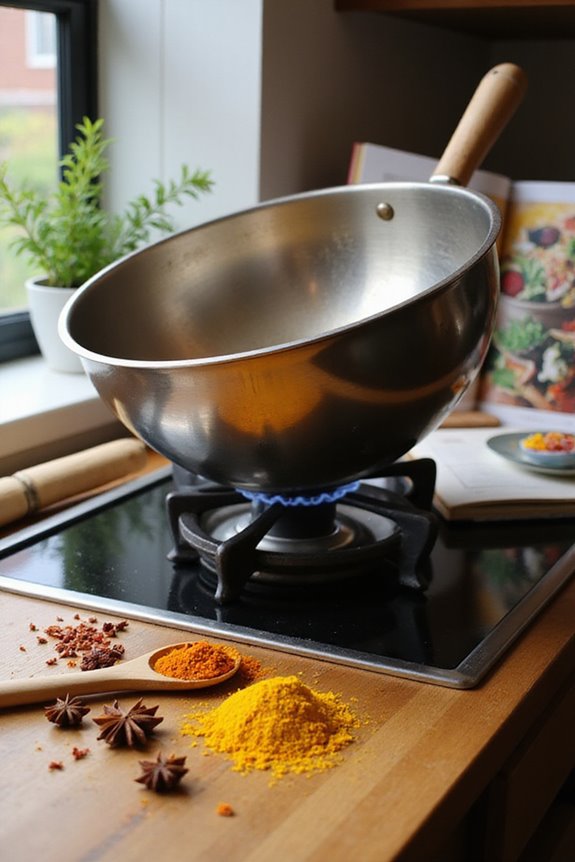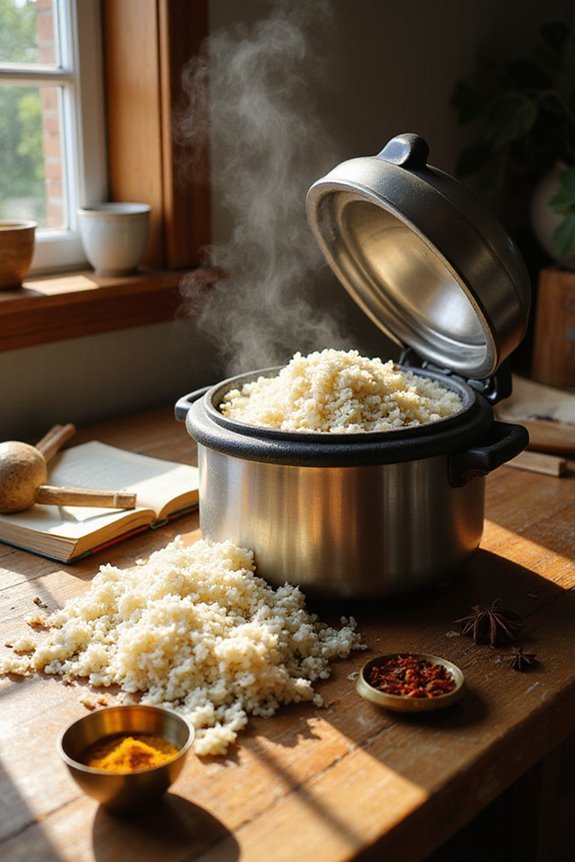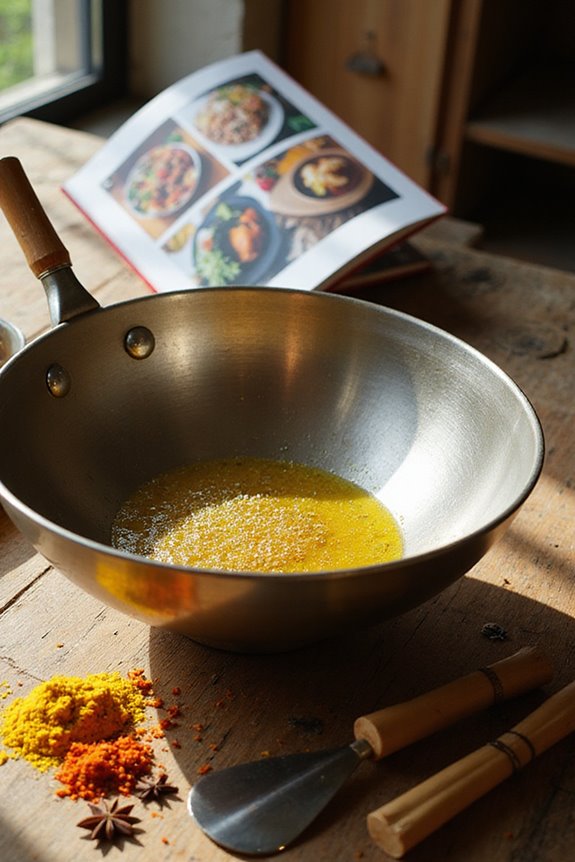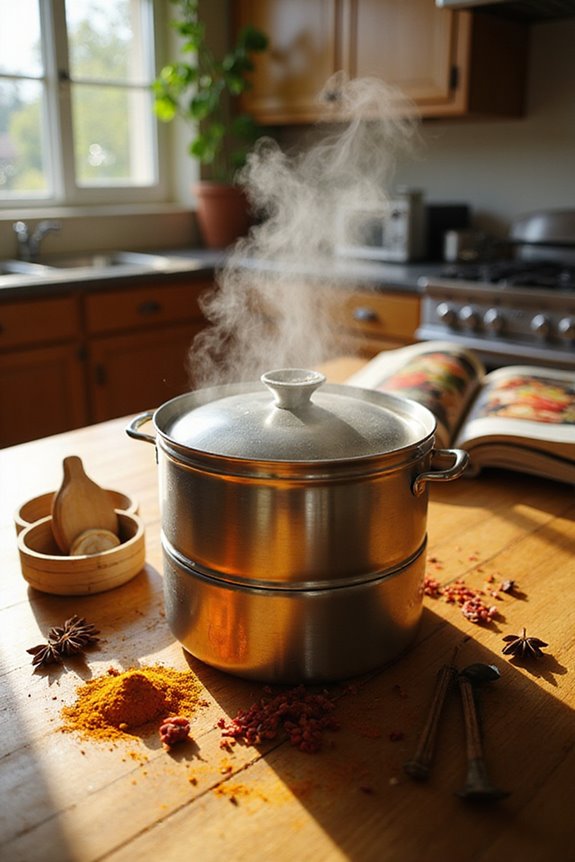To fix a wobbly wok on our stove, let’s start by checking a few things! First, make sure the wok fits the stove properly—size matters! Next, inspect the base for any warps or bends; a straight surface is key. Don’t forget to check if the stove is leveled and adjust its legs if needed. Finally, secure the handle tightly and keep it rust-free to keep our cooking magical! Stick around to discover even more tips for the perfect stir-fry!
Key Takeaways
- Ensure the wok size is appropriate for your stove and check for correct stove compatibility with the wok’s material.
- Inspect the wok’s base for any visible bends or bulges that could cause wobbling during cooking.
- Use a spirit level to check and adjust the stove’s leveling legs for a balanced cooking surface.
- Regularly check and secure the handle attachments on the wok to prevent wobbling and ensure safety.
- Opt for a high-quality carbon steel wok for better heat distribution and stability while cooking.
Identify the Cause of Wobbling
When it comes to our wobbly woks, figuring out the cause of the wobble is our first step to culinary bliss! Let’s dive right into it—whether we’re whipping up a delightful stir-fry or a magical noodle dish, we want our wok to dance precisely on the stove. Here’s what we need to check:
- Wok Size: Is our wok too large for the stove? A smaller stove may struggle to hold up large woks!
- Stove Compatibility: What’s the grate material? A sturdy cast iron grate offers more stability than stainless steel.
- Gas Jet Spacing: Higher BTUs can create uneven heating, turning our culinary drumming into a wobbly jam session! Additionally, using a high-quality carbon steel wok can enhance heat distribution and reduce the chances of wobbling during cooking.
Inspect the Handle for Stability
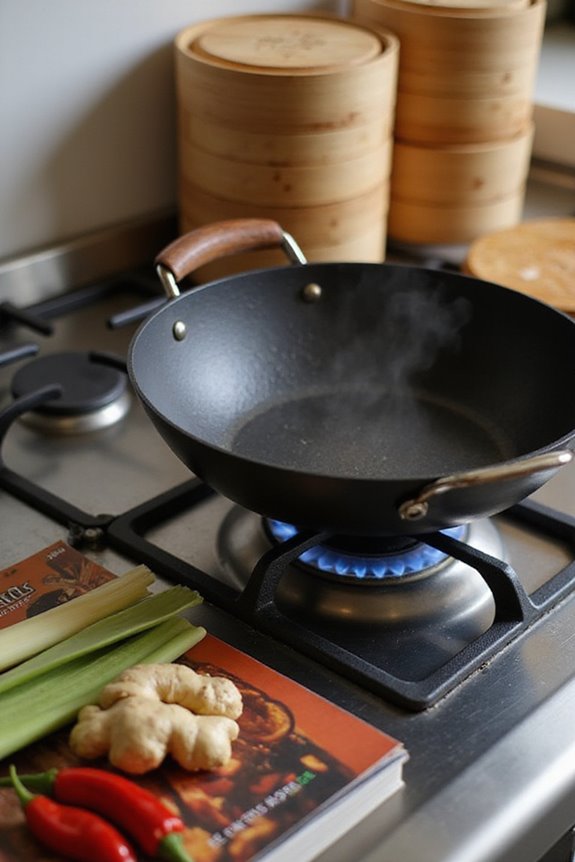
To guarantee our woks perform like culinary superstars, we need to take a closer look at the handles. First, let’s consider the handle types. Woks often feature loop handles, long handles, or Cantonese-style handles. Each serves a delightful ergonomic purpose, enhancing our cooking experience! It’s also important to think about the material considerations. Handles made of metal can be heat-conductive, while wooden handles offer that cozy touch but may require extra care.
Don’t forget to check for secure attachment! A wobbly handle can cramp our cooking style. So let’s make certain our handles are snug and stress-free. Additionally, using a heavy gauge carbon steel wok ensures better stability during high-temperature cooking. With these tips in mind, we can guarantee our woks are stable and ready to whip up some magical meals!
Check the Base for Warping
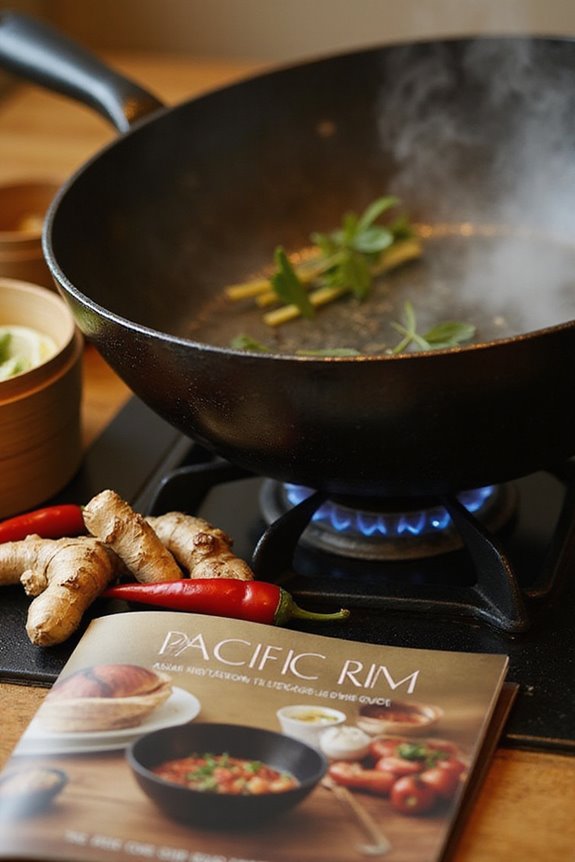
Base warping can be a real party crasher in our cooking adventures! For our beloved woks, this means a bumpy ride on the stovetop. Let’s kick off our base inspection by checking for visible bends and bulges. If our wok wobbles during cooking, it’s a sign that thermal expansion might have played a trick on us.
We can avoid this drama by:
- Heating our wok gradually to dodge those thermal shocks.
- Staying away from sudden cools—no cold water on hot woks, please!
- Investing in thicker, quality woks for even heating, which greatly impacts heat distribution efficiency.
Evaluate Rust Presence
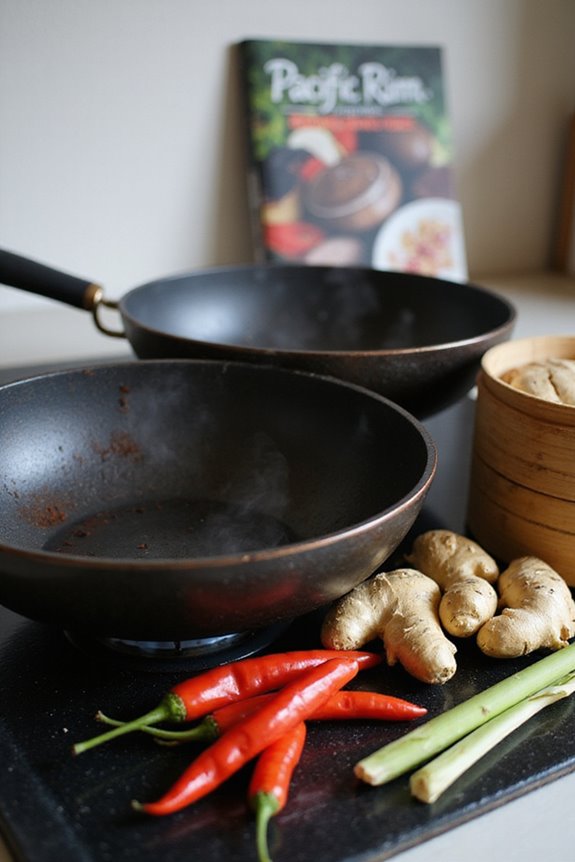
Rust can sneak up on us like a mischievous elf during the holidays, and it’s crucial to catch it early! Let’s perform a quick rust assessment. We’ll check for any rust spots or reddish-brown patinas on our beloved wok, usually hiding at the bottom or near handles.
If we find minor rust, a little steel wool and soap can work wonders. For stubborn rust, we might need something stronger like Barkeeper’s Friend. To boost our rust prevention efforts, remember to season our wok regularly and guarantee it’s completely dry after washing, just like caring for a Dolsot bowl ensures optimal cooking performance. A dry storage spot does wonders too! With these magic tips, we can keep our cooking adventures delightful and free from rusty surprises. Happy cooking, friends!
Ensure Stove Leveling
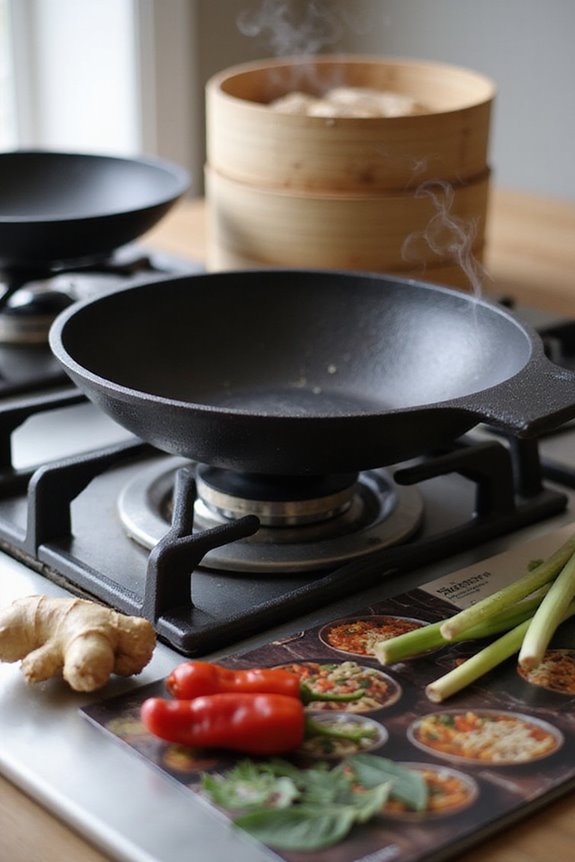
While preparing our kitchen for delightful cooking escapades, we may sometimes find our stove wobbling like a festive piñata. Let’s tackle stove leveling together! First, let’s check our countertop measurement by ensuring it’s even on both sides. Grab a spirit level and measure the floor under the stove; noting any height differences is essential.
Next, locate those leveling legs—usually four. Using an adjustable wrench, turn each leg clockwise to raise or counterclockwise to lower. It’s all about balance!
To enhance your cooking experience, ensure your stove setup can accommodate authentic Asian kitchen accessories, promoting stability and ease of use.
Finally, we’ll place a level diagonally across the oven racks to confirm everything’s steady. Once that’s done, we can celebrate with our perfectly stable wok, ready for delightful culinary creations! Happy cooking!
Fixing a Warped Base
Now that our stove is level and ready for action, let’s tackle the magical adventure of fixing a warped wok base! First, we’ll want to check the warp using a straightedge. This delightful tool helps us spot any irregularities and gauge how much wobble needs fixing. We’ll gently heat our wok for some metal malleability, making it easier to work with.
Next, let’s apply controlled pressure to the warped areas while it’s warm. Using a flat tool or even our hands, we can work on those bumps. Remember to check our progress often with that straightedge! With some patience and careful wok adjustments, we’ll soon have our trusty wok sitting flat and ready for our next delicious meal. Premium materials enhance the durability of your kitchen tools, ensuring they can withstand heat and pressure. Happy cooking!
Securing the Handle Properly
When it comes to ensuring our wok handle is secure, a little attention goes a long way! Loose handles can lead to some unmagical kitchen accidents. For screwed handles, let’s grab our trusty screwdriver for some handle tightening to keep things safe. If we’ve got riveted handles, it’s time for some fun with rivet peening! Using a hammer and punch, we can peen the rivets to secure the handle better. Don’t forget about wooden handles; they might need extra TLC in dry air to prevent shrinkage. Regularly checking our wok handles is key to keeping our cooking adventures delightful and worry-free. Let’s make our woks as dependable as a holiday sweater—ready for every cooking occasion!
Preventing Rust and Damage
After ensuring our wok handles are securely fastened, it’s time to focus on keeping our beloved cooking companion rust-free and fabulous! Let’s plunge into some delightful rust prevention and maintenance tips:
- Drying: Always dry the wok on the stove after washing. This quick step keeps rust at bay!
- Oil Barrier: Once dry, lightly coat it with a high smoke point oil, like avocado oil. Think of it as our wok’s cozy blanket!
- Storage Spot: Store it in a dry place, avoiding damp conditions—like leaving it in a wet dish rack.
- Regular TLC: Clean and maintain our wok regularly for the best results.
With these magical steps, our wok can stay shiny and ready for all our culinary adventures!
Maintaining a Stable Stove
To keep our culinary escapades delightful and accident-free, we need to maintain a stable stove that supports our beloved wok. Here’s how we can transform our cooking space:
- Use Wok Rings: These magical stove accessories create a perfect fit for our round-bottomed woks. By placing them directly on the burner, we eliminate wobbling and guarantee even heating.
- Inspect Stove Grates: A quick look at those grates might just save us from a big mess. If they’re damaged or uneven, it’s time to swap ’em out.
- Adjust Setup: Sometimes, inverting the grates can be a clever fix.
With these tips, we’ll master our cooking techniques and make every stir-fry session enjoyable and safe. Happy cooking, friends!
Proper Maintenance and Storage of the Wok
With a stable stove set up, we can focus on giving our beloved wok the proper love and care it deserves! Let’s keep our cooking magic alive with these delightful wok cleaning and seasoning techniques.
- Cleaning: After each use, we should use hot water and a gentle brush to keep it sparkling. Remember, no soap! Dry it thoroughly and add a thin layer of oil for protection.
- Seasoning: In the first few months, we’ll want to season regularly to create that fabulous non-stick layer. If food starts sticking, it’s time for a re-seasoning party!
Finally, let’s store our wok carefully—hanging is best, or using soft cloths when stacking. This way, our trusty wok remains ready for our next culinary adventure!
Frequently Asked Questions
Can Using a Wok on an Electric Stove Cause Wobbling?
We often find that using a wok on an electric stove can challenge wok stability. The design discrepancy and heat distribution can indeed lead to wobbling, making our cooking experiences less enjoyable and more complicated.
What Type of Wok Is Best for Preventing Wobble?
When it comes to preventing wobble, we’ve found that a flat-bottomed carbon steel wok works best. Its stability and heat distribution make cooking a joy, ensuring we enjoy our time together at the stove.
Is It Safe to Use a Wobbly Wok?
“Better safe than sorry,” we say. Using a wobbly wok compromises both stability and cooking safety. Let’s prioritize our kitchen safety together, opting for a stable wok to guarantee enjoyable cooking experiences without accidents.
How Often Should I Inspect My Wok for Stability?
When it comes to wok maintenance, we should conduct stability checks every cooking session, especially for daily users. Regular inspections guarantee safety, letting us enjoy cooking together without worrying about any wobbling mishaps.
What Alternatives to a Wok Can I Use for Stir-Frying?
For stir-frying, we’ve got great options! A non-stick skillet, cast iron pan, or stainless steel saucepan can create delicious dishes. Let’s embrace these versatile frying pans and discover new culinary possibilities together.

